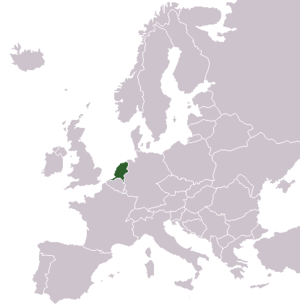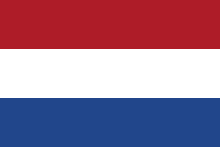Netherlands

The Netherlands also known, incorrectly, as Holland, is a small country in north west Europe. It shares borders with Germany and Belgium. The capital city is Amsterdam (but the Government is based in The Hague). Other big cities are the Hague, Rotterdam, Utrecht and Eindhoven. The Netherlands is part of the European Union and uses the Euro as its currency.
History of the Netherlands[edit | edit source]
Dutch history goes back many years. During the era of the Roman Empire the Batavians inhabited the region.

Modern history in the Netherlands begins in the 1560s. It was during this time that the Netherlands revolted against Spanish rule. Led by William of Orange, also called William the Silent, they declared their independence in 1581. The Netherlands was a republic, known as the United Provinces or the Dutch Republic. William was assassinated in 1584. In 1609 the Netherlands was at peace with Spain, but it was only for twelve years. In 1621 war broke out again, but the Spanish could not conquer the Netherlands and were forced to recognize Dutch independence in 1648.

In the 1600s the Netherlands reached its "golden age". It created an empire across the world. Dutch trade dominated the seas, and Dutch culture flourished. The Dutch went to war with the English three times in the 1600s and defeated the English twice.

Unfortunately for the Dutch, the Netherlands began to decline in power and leave the golden age in the early 1700s. In 1795 they were invaded and conquered by France. Napoleon Bonaparte set up a republic that did whatever he wanted, called "Revolutionary Netherlands" but he still thought he did not have enough control over the Dutch. So in 1806 he made his brother, Luis, king of the Netherlands, called the "Kingdom of Holland". But when Louis began to show more interest in the Dutch interests than in Napoleon's, Napoleon exiled him and made the Netherlands part of the French Empire in 1810.
After Napoleon was defeated in 1815, the United Kingdom of the Netherlands was created. King William I was the first King. Belgium was part of the Kingdom. The Belgians were mostly Catholic, and the Dutch mostly Protestant and the Belgians did not want to be ruled by the Dutch. So they revolted in 1830 and became independent in 1839.
During World War II the Netherlands was invaded and occupied by Germany. Many Dutch Jews were deported and killed in concentration camps but some survived because of the help of local people. Since the 1950s the Netherlands has lost its empire but become one of the richest and most liberal countries in the world. In 2001 the Netherlands was the first country in the world to allow Same Sex Marriage.
Geography of the Netherlands[edit | edit source]
The Netherlands is a low country, with no mountains. The highest peak is only 322 meters. Many rivers end in the Netherlands, one of those is the Rhine. If it were not for dikes, almost one third of the country would be below water. The Netherlands tends to have a moderate maritime climate, with cool summers and mild winters. The Netherlands has 20 national parks and hundreds of other nature reserves that include lakes, dunes, woods, and other habitats.

Dike — a barrier built to stop sea water from flooding the land
People of the Netherlands[edit | edit source]

Just under 17 million people live in the Netherlands. The official language is Dutch, which is spoken by most of the population, the exception being some groups of immigrants. There is a tradition of learning foreign languages in the Netherlands: about 70% of the total population have good knowledge of English, 55– 59% of German, and 19% of French. Some Dutch secondary schools also teach Latin and Ancient Greek. The majority of Dutch people are Christian and a minority are Muslim.
Sights of the Netherlands[edit | edit source]
The Netherlands is one of the biggest tourist centres in the world with 10 million visitors every year. The highest number of tourists are from Germany and the United Kingdom. Tourists come for the artistic and cultural attractions as well as the city life in Amsterdam. Gay visitors are attracted to the Netherlands because of its respect of LGBT (Lesbian, Gay, Bisexual and Transsexual) rights and carnivals and celebrations are held through out the summer months. Other Europeans visit because of the country's tolerance on soft drugs (cannabis) and for music and theatre festivals.
There are 9 UNESCO World Heritage Sites in the Netherlands including one in the Caribbean. The most visited Heritage Site is the Seventeenth-century canal ring area of Amsterdam - a collection of canals which encircle the centre of Amsterdam.
| Wikijunior Europe • Intro • EU • Geo • People • Language • Facts • Quiz | edit | ||
